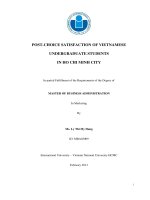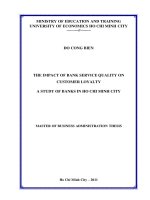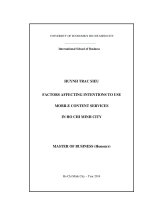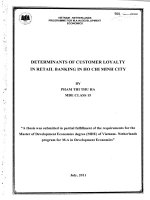1165 factors affecting customer satisfaction when using digital banking in ho chi minh city 2021
Bạn đang xem bản rút gọn của tài liệu. Xem và tải ngay bản đầy đủ của tài liệu tại đây (905.08 KB, 106 trang )
STATE BANK OF VIETNAM
THE MINISTRY OF
EDUCATION AND TRAINING
BANKING UNIVERSITY OF HO CHI MINH CITY
LAC HONG NHU
FACTORS AFFECTING THE SATISFACTION OF
CUSTOMERS WHEN USING DIGITAL BANKING IN
HO CHI MINH CITY
GRADUATE THESIS
MAJOR: FINANCE – BANKING
CODE: 7340201
HO CHI MINH CITY, 2021
LAC HONG NHU
FACTORS AFFECTING THE SATISFACTION OF
CUSTOMERS WHEN USING DIGITAL BANKING IN
HO CHI MINH CITY
GRADUATE THESIS
MAJOR: FINANCE – BANKING
CODE: 7340201
SUPERVISOR
M.Sc VO THI NGOC HA
HO CHI MINH CITY, 2021
i
ABSTRACT
The goal of this research is to use the modified SERVPERF model to assess
customer satisfaction and the influence of these dimensions (interface, reliability,
responsiveness, empathy, security, and price) on customer satisfaction in three
digital banks in Ho Chi Minh City (Timo, Tnex, and Cake).
Data is collected from 304 Timo, Tnex, and Cake consumers. The SPSS 20 program
statistically evaluated the sample data using exploratory factor analysis, factor
analysis, descriptive statistics, correlation analysis, and regression to assess service
quality perception and customer satisfaction.
The results show that customer satisfaction is influenced by six factors: interface,
reliability, responsiveness, security, empathy, and price. The reliability factor has a
positive impact on customer satisfaction with a statistical significance of 90% while
the remaining factors have a positive impact on customer satisfaction with a
statistical significance of up to 95%. The study's findings also revealed that there
was no difference in satisfaction between genders but there is a difference in
satisfaction with age group and occupations.
Finally, the paper provides management implications for digital banks to enhance
their service quality, as well as points out some limitations of the research, and
suggests future research directions.
DECLARATION
I hereby declare that this is my own research under the supervision of MSc. Vo Thi
Ngoc Ha. The truthful data, content, results, tables, and images used for
commenting and analysis collected from various sources are cited and clearly
stated in the references section. In addition, comments, reviews as well as results
of other authors will be fully cited.
The Author
Lạc Hồng Như
ACKNOWLEDGEMENTS
I would like to express my sincere thanks to all the professors at Banking University
of Ho Chi Minh City for their patience and dedication in teaching and imparting
practical and useful knowledge to me over the past four years, especially MSc. Vo
Thi Ngoc Ha, who directly guided and helped me complete my graduation thesis.
Due to limited knowledge and practical experience, my research still has many
shortcomings. I am looking forward to receiving your advice and comments to
improve this thesis.
Finally, I wish you all health and success in your career.
Best regards.
The Author
Lạc Hồng Như
ABBREVIATION LIST
Abbreviation
Description
DB
Digital Banking
Fintech
Financial technology
SBV
State bank of Vietnam
VP Bank
Vietnam Prosperity Joint Stock
Commercial Bank
MSB
Vietnam Maritime Commercial Joint
Stock Bank
LIST OF TABLE
Table 2.1 The difference between Digital banking and e-banking............................. 8
Table 3.1 Encrypt data for Interface component...................................................... 29
Table 3.2 Encrypt data for Reliability component................................................... 30
Table 3.3 Encrypt data for Responsiveness component........................................... 30
Table 3.4 Encrypt data for Security component....................................................... 31
Table 3.5 Encrypt data for Empathy component...................................................... 31
Table 3.6 Encrypt data for Price component............................................................ 32
Table 3.7 Encrypt data for Satisfaction component................................................. 32
Table 3.8 Summary of correlation between factors and customer satisfaction.........32
Table 4.1 Survey sample characteristics.................................................................. 45
Table 4.2 Descriptive Statistics................................................................................ 49
Table 4.3 Cronbach's Alpha test results for independent variables..........................50
Table 4.4 Cronbach's Alpha test results for dependent variable............................... 50
Table 4.5 KMO and Bartlett's Test for independent variables.................................. 51
Table 4.6 Total Variance Explained for independent variables................................ 52
Table 4.7 Rotated Component Matrix for independent variables............................ 53
Table 4.8 KMO and Bartlett's Test for dependent variable...................................... 54
Table 4.9 Total Variance Explained for dependent variable..................................... 54
Table 4.10 Component Matrix for dependent variable............................................ 55
Table 4.11 Pearson Correlation Analysis................................................................. 55
Table 4.12 Regression analysis................................................................................ 57
Table 4.13 ANOVA................................................................................................. 57
Table 4.14 Coefficients............................................................................................ 57
Table 4.15 Test of Homogeneity of Variances between Genders............................. 59
Table 4.16 ANOVA test between Genders............................................................... 59
Table 4.17 Test of Homogeneity of Variances between Age groups........................60
Table 4.18 ANOVA test between Age groups......................................................... 60
Table 4.19 Test of Homogeneity of Variances between Occupations.......................60
Table 4.20 ANOVA test between Occupations........................................................ 61
LIST OF FIGURES
Figure 2.1 Digital bank models............................................................................... 13
Figure 2.2 The SERVQUAL model......................................................................... 18
Figure 2.3 The GRONROOS model........................................................................ 21
Figure 3.1 Proposed research model........................................................................ 28
Figure 4.1 Level of research and implementation of digital transform strategies of
commercial banks in Vietnam........................................................................... 42
Figure 4.2 Digital transformation model in Vietnam............................................... 43
TABLE OF CONTENTS
ABSTRACT.............................................................................................................. i
DECLARATION..................................................................................................... ii
ACKNOWLEDGEMENTS................................................................................... iii
ABBREVIATION LIST......................................................................................... iv
LIST OF TABLE..................................................................................................... v
LIST OF FIGURES.............................................................................................. vii
TABLE OF CONTENTS..................................................................................... viii
1
CHAPTER 1: INTRODUCTION.................................................................... 1
1.1
Reasons for choosing the topic........................................................................ 1
1.2
Research objectives......................................................................................... 3
1.3
Research questions.......................................................................................... 3
1.4
Research subjects............................................................................................ 3
1.5
Research methods............................................................................................ 4
1.6
Contribution.................................................................................................... 4
1.7
Structure of research........................................................................................ 5
2
CHAPTER 2: THEORETICAL BASIS AND LITERATURE REVIEW....7
2.1
Overview of digital banking............................................................................ 7
2.1.1
Definition of digital banking........................................................................ 7
2.1.2
Benefits and limitations of digital banking................................................... 9
2.1.2.1
Benefits of digital banking.................................................................... 9
2.1.2.2
Limitations of Digital Banking............................................................ 12
2.1.3
Forms of digital banking............................................................................ 12
2.1.4
Perspectives on service quality and customer satisfaction.........................14
2.1.4.1
Definition of service quality................................................................ 14
2.1.4.2
Definition of customer satisfaction...................................................... 14
2.1.4.3
The relationship between service quality and customer satisfaction....16
2.1.5
Theoretical models to measure service quality........................................... 17
2.1.5.1
The SERVQUAL model...................................................................... 17
2.1.5.2
The SERVPERF model....................................................................... 19
2.1.5.3
The GRONROOS model..................................................................... 20
2.1.5.4
The BSQ model................................................................................... 21
2.2
Literature review........................................................................................... 22
2.2.1
Vietnamese studies..................................................................................... 22
2.2.2
International studies................................................................................... 23
3
CHAPTER 3: RESEARCH METHOD......................................................... 27
3.1
Research model............................................................................................. 27
3.2
Variable description....................................................................................... 28
3.2.1
Interface..................................................................................................... 29
3.2.2
Reliability................................................................................................... 29
3.2.3
Responsiveness........................................................................................... 30
3.2.4
Security...................................................................................................... 31
3.2.5
Empathy..................................................................................................... 31
3.2.6
Price........................................................................................................... 32
3.2.7
Satisfaction................................................................................................. 32
3.3
3.3.1
Data collection method and technique........................................................... 33
Data collection method.............................................................................. 33
3.3.2
3.4
Sample size................................................................................................. 33
Data analysis method and technique.............................................................. 35
3.4.1
Cronbach Alpha's confidence coefficient method....................................... 35
3.4.2
Exploratory factor analysis (EFA).............................................................. 35
3.4.3
Regression analysis method....................................................................... 36
3.4.4
ANOVA (analysis of variance).................................................................... 38
4
CHAPTER 4: RESULTS AND FINDING.................................................... 39
4.1
The reality of digital banking in Vietnam...................................................... 39
4.1.1
The legal framework.................................................................................. 39
4.1.2
The status of digital banking implementation in Vietnam........................... 41
4.1.2.1
Timo.................................................................................................... 43
4.1.2.2
Cake.................................................................................................... 44
4.1.2.3
Tnex.................................................................................................... 45
4.2
Descriptive statistical analysis....................................................................... 45
4.2.1
Descriptive statistics of the survey sample................................................. 45
4.2.2
Descriptive statistics of the variables in the model.................................... 49
4.3
Evaluate the reliability of the scale with Cronbach Alpha’s coefficient.........49
4.3.1
Testing the reliability of the scale by using Cronbach alpha’s coefficient for
the independent variables................................................................................. 49
4.3.2
Testing the reliability of the scale by using Cronbach alpha’s coefficient for
the dependent variable...................................................................................... 50
4.4
Exploratory factor analysis (EFA)................................................................. 51
4.4.1
Exploratory factor analysis for independent variables..............................51
4.4.2
Exploratory factor analysis for dependent variable................................... 54
4.5
Analysis of multivariate regression models and hypothesis testing...............55
4.5.1
Correlations analysis................................................................................. 55
4.5.2
Regression analysis.................................................................................... 56
4.5.3
Test the hypotheses..................................................................................... 59
4.6
Analysis of variance (ANOVA)..................................................................... 59
4.7
Discussion..................................................................................................... 61
5
CHAPTER 5: CONCLUSION AND MANAGEMENT IMPLICATION. .64
5.1
Conclusion..................................................................................................... 64
5.2
Management Implication for Digital Banking............................................... 65
5.2.1
Interface..................................................................................................... 65
5.2.2
Responsiveness........................................................................................... 66
5.2.3
Empathy..................................................................................................... 67
5.2.4
Security...................................................................................................... 67
5.2.5
Reliability................................................................................................... 68
5.2.6
Price........................................................................................................... 69
5.3
Limitations of the topic and future research directions.................................. 69
5.3.1
Limitations of the topic............................................................................... 69
5.3.2
Recommendations for future research........................................................ 70
REFERENCES......................................................................................................... i
APPENDIX........................................................................................................... viii
1
CHAPTER 1: INTRODUCTION
1.1 Reasons for choosing the topic
A revolutionary breakthrough in technology brings incalculable benefits as well as
challenges for businesses in all domains, especially the financial and banking industry.
The advancement by leaps and bounds of technology requires banks need to
innovate to be able to cater to customers’ needs as well as survive and thrive in the
digital economy of the 21st century. Financial technology (FinTech) has created a
new step for the financial market worldwide by reshaping consumers’ relationships
with their banks. In order to satisfy customers' requirements as well as save costs,
banks have moved more toward digital banking (DB). Moreover, during this
uncertain time due to the coronavirus, when social distance is a requirement to fight
off the pandemic, DB is more referred to by both the providers and customers. It
helps to make sure that the banks are able to keep up with the market's demand
while protecting the health of their employees, customers, and society.
DB has many benefits which boost the next wave of a global economic surge. Even
though DB had been widely used internationally, it is still a very new aspect of the
Vietnamese market. Therefore, Vietnam is considered as a potential market, an
opportunity for the development of digital banking. With 96.5 million people, the
majority of which are young people, account for about 70%, and at the same time,
72% of the population own smartphones, 130 million mobile subscribers, 64 million
Internet users (Thieu Quang Hiep, 2020) so it is possible to expand digital banking
in Vietnam. Statistics from the State Bank of Vietnam (SBV) show that up to 94%
of commercial banks are implementing or building a digital transformation strategy.
Along with the development of socio-economic as well as science and technology,
the number of people using banking services via the internet and mobile phone is
increasing day by day. According to the SBV (2020), the number and value of
payments via internet channels reached 282.4 million transactions with 17.4 million
billion VND, that via mobile phone channel reached 682.3 million transactions with
nearly 7.2 million billion VND. Vietnam currently has about 30 million people
using the internet banking payment system every day, so the development of DB is
very necessary for banks if they want to develop sustainably in this era.
In fact, many banks consider DB as the focus of development in recent years such
as Timo, Tnex, and Cake. These DB have completely separated the service
distribution channel into a branch that operates independently on a digital platform,
having services and marketing policies are completely independent of the parent
bank. Timo is the first digital bank in Vietnam, which is first developed by Vietnam
Prosperity Joint Stock Commercial Bank (VP Bank) in 2016 and then cooperate
with Viet Capital Bank and is one of eight reputable digital banks in Asia. In 2020,
Vietnam Maritime Commercial Joint Stock Bank (MSB) sponsors Tnex digital
bank. Cake was known as Yolo and was established by VP bank in 2018, then VP
Bank cooperated with Be Financial and changed its name to Cake in 2021. This is
the first and the only one at the moment application in Vietnam that has a digital
bank that displays and connects inside the ride-hailing application.
In Vietnam, although there have been many studies related to customer satisfaction
when using internet banking services. However, no research has been conducted on
the scope of digital banking services and banks should pay attention to improving
customer satisfaction. In order to ensure that DB has the potential to expand and
reach more customers, it is required to study the factors affecting digital banking
development in Vietnam. Therefore, the topic of factors affecting customer
satisfaction when using DB in Ho Chi Minh city is conducted to help banks
understand customer behavior better and offer appropriate solutions simultaneously
to improve service quality so that banks can meet the needs of customers as well as
help DB become more developed. Stemming from the above reasons, the topic
"Factors affecting customer satisfaction when using digital banking in Ho Chi Minh
City" had been chosen.
1.2 Research objectives
The overall goal of this thesis is to identify factors affecting customer satisfaction
when using DB in Ho Chi Minh city. After building research models and evaluation
analysis, this thesis will propose solutions for DB to improve service quality in
order to increase customer satisfaction.
In addition to the general objective, the study also has the following specific
objectives:
Determine factors that may affect customer satisfaction.
Assessing the level of impact of factors on customer satisfaction.
Giving a conclusion and recommendation for DB in Vietnam to improve the
quality of services.
1.3 Research questions
This study is designed to answer the following questions:
What factors affect customer satisfaction when using DB?
How do factors impact customers satisfaction?
What solutions can be drawn to improve the quality of DB in Ho Chi Minh
city?
1.4 Research subjects
Research subjects:
The satisfaction of customers when they use DB in Ho Chi Minh city.
Research scope:
Time range: from June to September 2021
Space range: Ho Chi Minh City, Vietnam
Respondents: Customers have used DB services which are Timo, Tnex, and
Cake.
Services studied: Timo, Tnex, and Cake.
1.5 Research methods
The research is inherited from previous studies, combined with qualitative and
quantitative research to identify and evaluate the factors affecting customers’
satisfaction when using DB. At the same time, a number of issues that need
attention in order to improve the quality of DB are also raised.
Qualitative methods: Qualitative research is used to synthesize and compare
theories, legal regulations, and previous studies related to DB. Besides that, it is also
used to perform descriptive statistics of DB activities such as the status of DB in
Vietnam, specifically Timo, Tnex, and Cake.
Quantitative methods: The official study was carried out by quantitative research
method in order to test the scale in the research model through a questionnaire
survey of customers who are using DB in Ho Chi Minh city. Quantitative research
will be used to explore and discuss opinions by using a questionnaire-based method
built on the research model. The table of questionnaires is formed and a survey of
304 customers who have used DB services will be conducted at Ho Chi Minh City.
After processing the data collected from the survey, the scale will be tested by
Cronbach's Alpha reliability coefficient, exploratory factor analysis (EFA), and
multiple regression analysis to test the model through statistical software SPSS 20.
Finally, measuring the influence of each factor on the satisfaction of customers’
using DB and making recommendations to improve the quality of DB in Ho Chi
Minh city.
1.6 Contribution
Scientific significance: There are very few studies related to the topic of DB, most
of them just focus on factors affecting the intention of using DB or about other
services. A few studies mention customer satisfaction using digital banking, but
only research in digital banks at a low level (just digitizing some banking services).
Therefore, this study can be considered as one of the few studies on customer
satisfaction when using DB in Ho Chi Minh city, with the highest level digital banks
in Vietnam. Besides that, this study provides empirical evidence to confirm factors
affecting the satisfaction of customers when using DB and can be used as a
reference for future research papers on the same topic.
Practical significance: DB is more commonly referred to by both providers and
consumers during this uncertain period owing to the Coronavirus when social
distance is a must to combat the pandemic. DB contributes to ensuring that banks
can meet market demand as well as safeguarding the health of their workers,
customers, and society. The results of this study can become a reference source for
commercial bank managers to deeply understand customers' behaviors and provides
suggestions for improving the quality of DB. As a result, banks can cater to
customer’s needs in a better way as well as increase their competitive position.
1.7 Structure of research
This study consists of five following chapters:
Chapter 1: INTRODUCTION
Describing reasons for selecting the topic as well as stating research objectives,
research questions, subjects, research methods, contributions in practice, and
scientific studies.
Chapter 2: THEORETICAL BASIS AND LITERATURE REVIEW
Describing some theories about DB, service quality, customer satisfaction and
reviewing previous empirical researches as a basis for proposing a research model.
Chapter 3: RESEARCH METHOD
Presenting research model, variable description, scale, model's hypotheses research
methods, methods of data sampling and processing as well as building and testing
scales to measure the impact of factors on customers’ satisfaction.
Chapter 4: RESULTS AND FINDING
Highlighting the legislative frameworks related to DB in Vietnam, the establishment
of digital banks in Vietnam, especially the present status of Timo, Tnex, and Cake's.
Simultaneously, presenting results from the estimation model and discussing the
obtained result.
Chapter 5: CONCLUSION AND MANAGEMENT IMPLICATION
Summarizing the main findings of the study. At the same time, giving some
suggestions to improve the quality of DB in Ho Chi Minh city. This research will
also create a basis for others to continue exploring and developing while showing
some limitations of the research and proposing further research directions.
CHAPTER 2: THEORETICAL BASIS AND LITERATURE REVIEW
2.1 Overview of digital banking
2.1.1 Definition of digital banking
The first country in the world to develop a digital banking platform is Singapore,
and DBS Bank (Singapore) which was established in 1968 is considered as the first
digital bank in the world. Moreover, this bank is the best-rated bank among other
digital banks nowadays. Currently, nations around the world have also been
developing this platform with typical digital banks are Royal Bank of Scotland, Uni
Credit (Italia), Bank of America, Barclays (England), HSBC (England), Banco
Santander (Spain), and JP Morgan Chase (America).
There are many definitions of the concept and function of DB from many different
researchers. The way researchers approach DB will give different thinking, but
there are similarities between the ways of explaining.
Digital Banking is a form of banking that digitizes all traditional services and
operations of the bank (Skinner, 2014). To put it another way, all services that
customers can do at a traditional bank are all available via the website or mobile
applications and customers just need a smartphone with an internet connection to
perform these services without going to the bank. At the same time, the banks’
activities such as risk management, capital management, sales management, product
development, and marketing are also digitized. Besides that, Kelman (2016) supposed
that DB can cover all aspects of a common bank such as organizational structure,
human resource management, operations, and services. In other words, DB has full
functions of a traditional bank, from organizational structure to working process,
products and services, documents, and transaction methods with customers while ebanking just a system was created to complement services on traditional banking
platforms. Digital Banking could be considered as no-branch banking or auto
banking (Scardovi, 2017). It means that a bank can operate online 100% without a
transaction office or a branch and face-to-face meetings.









